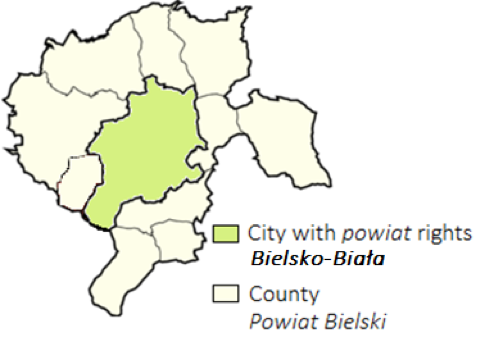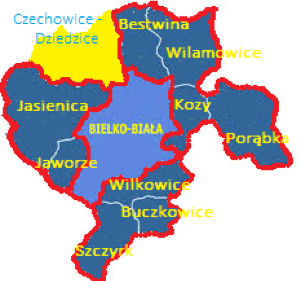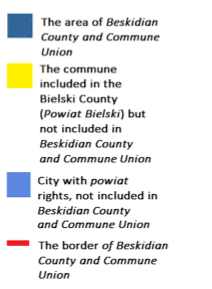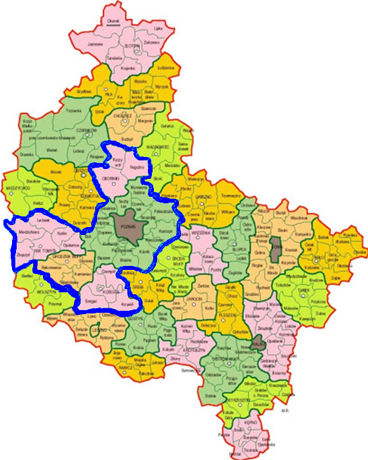Andżelika Mirska, University of Warsaw
Relevance of the Practice
Local government units may cooperate with each other in the public tasks realization. The right to voluntary cooperation is guaranteed by the Polish Constitution (Article 172) and the European Charter of Local Self-Government (Article 10). Three legal forms may be adopted in cooperation: (i) unions (ii) agreements (iii) associations.
- The union of local government units implies that local governments implement a new separate legal unit with legal personality to delegate their task(s) to the unit for performance. Thus, the tasks delegated to the union, throughout its existence, cease to be the tasks of local government units forming the union.
- The agreement of local government units implies that no new legal entity is created, merely one local government unit delegates its tasks to another one.
- The associations – their objective is different. The point is not about the local governments tasks performing but rather about ‘supporting and promoting the idea of local government and common interests of local government units’[1]. Regarding associations, a new legal entity is referred to, similar to a union, adopting its statute and operating through its legal organs (authorities).
Ever since the commune (gmina) government was reinstated in 1990, unions, agreements and associations have been able to be established by communes among themselves (intermunicipal cooperation). Also counties (powiats) could cooperate with each other in these three legal forms since their establishment in 1999.
Intergovernmental cooperation (between communes and counties) was possible in the form of agreements and associations. Unions could merely be established at one level, either solely between communes (gminas) or between counties (powiats).
Revolutionary change occurred in 2016. It is henceforth possible to create intergovernmental unions, namely between counties (powiats) and communes (gminas). The establishment of more sustainable and transparent form of local tasks performing was the main purpose. The union may serve primarily the joint performance of tasks concerning public local transport, education or road management.
The decision about the union establishment is made by the representative authority of local government units (the commune council and the county council). Furthermore, the statute is also adopted by local government units. The union operates through its own authorities, including the union’s assembly (as a regulatory and controlling authority) and the union board (as the executive authority). All unions must be listed in the central ‘union register’ kept by the minister responsible for public administration[2] (currently: Ministry of the Interior and Administration of Poland).[3]
Currently (February 2021), 13 county and commune unions (związek powiatowo-gminny) are registered. The organization of local public transport is the most common objective of union establishment (9 unions). Moreover, other tasks include tourism promotion and development, and environmental protection. The number of local government units establishing a county and commune union varies from 2 to 15.
Description of the Practice
The example of intergovernmental union is the Beskidian[4] County and Commune Union (Beskidzki Związek Powiatowo-Gminny) established in 2017. The union was established to perform tasks concerning the local public transport sector. The union consists of 10 local governments units from two levels, including the Bielski County (Powiat Bielski) and 9 communes (gminas) located in the county territory.[5]
The Bielski County (Powiat Bielski) is the example of the ‘bagel-county’.[6] Accordingly, its territory consists of communes surrounding a separate city with county (powiat) rights (Bielsko-Biała). The population of the city with county (powiats) rights Bielsko-Biała is 170,303. The Bielski County population is 159,241.

The city with county (powiat) rights (Bielsko Biała) is not included in the Beskidian County and Commune Union. However, there are apparent functional links between the Bielski County (Powiat Bielski) and the City of Bielsko-Biala. An essential place is occupied by the city, constituting the center of work, education, health protection and culture for the inhabitants of the neighboring communes (gminas) belonging to the Bielski County (Powiat Bielski). Additionally, links are strengthened by the fact that the City of Bielsko-Biala is the seat of the Bielski County (Powiat Bielski) authorities. The City of Bielsko Biala provides and finances own public transport within its territory so the city has shown no interest in participating in the Beskidian County and Communes Union.
One commune of the Bielski County (Powiat Bielski) has not been included in the Beskidian County and Commune Union. It is an urban-rural commune with the City of Czechowice-Dziedzice inhabited by 35,631 people. The city provides own-account public transport.


| No | Commune name | Commune type | Population | Area | Population density (inhabitants/sq. km) |
| 1 | Bestwina | Rural | 11,441 | 37.92 km² | 301.7 |
| 2 | Buczkowice | Rural | 11,126 | 19.33 km² | 571.7 |
| 3 | Jasienica | Rural | 23,471 | 91.714 km² | 256.0 |
| 4 | Jaworze | Rural | 7299 | 21.13 km² | 342.4 |
| 5 | Kozy | Rural | 13,024 | 26.9 km² | 484.2 |
| 6 | Porąbka | Rural | 15,420 | 64.59 km² | 239.3 |
| 7 | Wilkowice | rural | 13,327 | 33.9 km² | 87.4 |
| 8 | Wilamowice | urban-rural | 17,017 | 56.72 km² | 296.8 |
| 9 | Szczyrk | urban (city) | 5734 | 39.07 km² | 146.76 |
| No | County name | Population | Area | Population density (inhabitants/sq. km) |
| 1 | Bielski County (Powiat Bielski): 10 communes (gminas) | 165,960 | 458.64 km² | 361.9 |
The Beskidian County and Commune Union operates on the basis of its statute, adopted by the local government units forming the union. Tasks, authorities, assets and sources of financing are regulated by the statute concerning the union.[9]
The union performing its tasks operates through the following bodies:
- the Assembly;
- the Management Board;
- the Audit Committee.
The assembly consists of two representatives from each local government units forming the union. Additionally, a member and a chairman of the assembly is the head of the Department of Communication and Transport in the County Office (Starostwo Powiatowe) with the total number of 23 members.
The Management Board of the union (an executive body) consists of 11 members comprising of an executive authority (mayor) from each commune. The representative of the Bielski County (Powiat Bielski) is the County Governor (starosta) as the executive body chairman in the county (powiat). The director of the union’s office is also a member of the management board.
Primarily, the union meets the requirements related to the rural communes. The new legal form assures communes equal participation, interest representation and transparency in the task performance of providing public transport to inhabitants. Before the union establishment, the aforementioned task was performed by the Bielski County (Powiat Bielski), and the communes concluded an agreement with the county delegating the task to the county. According to the Head of the Jaworze commune, of which the commune is a member of Beskidian County and Communes Unions, ‘until the Beskidian County and Communes Union was established, the Bielski County was responsible for local public transport, and it was financed by communes (under an agreement). Nowadays, we are entering a new reality. The communes of Beskidian County and Communes Union are becoming a full-fledged entity co-deciding on the tasks implementation in the field of public transport, and the Beskidian County and Communes Union is becoming the organizer of public transport in our area. Thus, communes, and not only county, acquire the right to control the way this task is performed, which has not been the case so far.’[10]
Currently, transports are organized on the territory of all communes belonging to the Bielski County (Powiat Bielski) and on the area of 4 communes that are not involved to the union on the basis of concluded agreements. All vehicles are insured with free Wi-Fi Internet access. From 1 January 2018, people over the age of 70 may travel free of charge by public transport organized by the union.
The union also obtains external funds originating in the European Union and the Polish Government. Therefore, modern ecological vehicles powered by compressed natural gas (CNG) can be purchased. In return, 17 diesel buses will be scrapped, which will positively affect the environment, thus contributing to the low-emission promotion.[11]
Assessment of the Practice
The intergovernmental form of cooperation becomes increasingly significant. For instance, another similar union is in the process of being created in the area of Wielkopolska Voivoidship. 23 local government units will be included with the number of 5 counties (powiats) and 18 communes (gminas). However, there will be a significant difference from the example discussed above. Namely, the new union will also include a centrally located city with county (powiat) rights, i.e. the City of Poznań, which is the fifth largest city in Poland with 533,830 inhabitants.
In 2019, the Mayor of Poznań informed neighboring local governments about the bad financial results of the local transport Motor Transport Company (Przedsiębiorstwo Komunikacji Samochodowej, PKS). Shutdown was considered in this case as the City of Poznań could not afford to finance bus transport for the neighboring communes and counties not contributing to the costs at all. An agreement was reached and a new county and commune union called Wielkopolski Regional Transport (Wielkopolski Transport Regionalny) will be established by April 2021 and be operational in July 2021. Transport costs will be covered by all participants in proportion to the frequency and the length of bus travel in each of the communes and counties.

References to Scientific and Non-Scientific Publications
Ziemski K and Misiejko A, ‘Organizacja publicznego transportu zbiorowego przez jednostki samorządu terytorialnego ze szczególnym uwzględnieniem prawnych aspektów współdziałania’ (University of Adam Mickiewicz 2016) <https://repozytorium.amu.edu.pl/bitstream/10593/21982/1/Ziemski%2C%20Misiejko_organizacja%20publicznego%20transportu%20_internet.pdf>
[1] Art 84(1) of the Act of 8 March 1990 on Gmina Self-Government.
[2] Karolina Ołtarzewska, ‘Zarejestruj, zmień statut lub wyrejestruj związek międzygminny, związek powiatów, związek powiatowo-gminny’ (Ministry of the Interior and Administration, 2 July 2019) <https://www.gov.pl/web/mswia/zarejestruj-zmien-statut-lub-wyrejestruj-zwiazek-miedzygminny-zwiazek-powiatow-zwiazek-powiatowo-gminny> accessed 15 January 2021.
[3] See the website of the Ministry of the Interior and Administration, <https://www.gov.pl/web/mswia-en>.
[4] Beskids is the name of the geographical region of southern Poland, the mountain ranges in the Carpathians, where the local government units of the union are located.
[5] ‘BZPG – Informacje ogólne’ (Beskidzki Związek Powiatowo Gminny) <https://www.bzpg.pl/index.php/o-bzpg/> accessed 15 January 2021.
[6] For more information on ‘bagel’ – territorial units in Poland, see report section 4.1. on the Structure of Local Government in Poland.
[7] Own elaboration, with the map taken from D T G <https://pl.m.wikipedia.org/wiki/Plik:Powiat_bielski_(%C5%9Bl%C4%85ski)_-_Mapa.png>.
[8] Own elaboration, with the map taken from Starostwo Powiatowe <http://www.gminy.pl/powiaty/271.html>.
[9] Statute of the Beskidian County and Commune Union – consolidated text of 30 October 2018, <https://bzpg.bip.gov.pl/statut-zwiazku/tekst-jednolity/statut-beskidzkiego-zwiazku-powiatowo-gminnego.html> accessed 15 January 2021.
[10] Statement of the Mayor of the Jaworze commune, Radosław Ostałkiewicz, of 24 April 2018, <https://ostalkiewicz.com/2018/04/24/nowy-pks/> accessed 20.09.2021
[11] ‘Report on the State of the Bielsko County for 2019’ (Bielsko County 2019) <https://www.powiat.bielsko.pl/bielsko_powiat_2019/web/uploads/temp/strony/strona_326/text/Raport%20o%20stanie%20Powiatu%20Bielskiego%20%20za%202019.pdf> accessed 15 January 2021.
[12] Own elaboration, with the map taken from Okonek Gminny Internet Porta l <www.okonek.pl/asp/pl_start.asp?typ=14&menu=70&strona=1&sub=58>.
